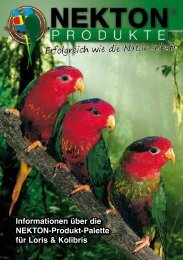Create successful ePaper yourself
Turn your PDF publications into a flip-book with our unique Google optimized e-Paper software.
sawing notches and the tongue resembling<br />
a brush, which gave the birds their nickname<br />
”Brush-tongued Parrots”. This tongue tipped<br />
with elongated papillae is an anatomical<br />
modification for collecting the bird‘s dietary<br />
staples of pollen, nectar and the juices of flowers,<br />
tree sap and the flesh of soft over-ripe<br />
fruit. Nectar and pollen are the main parts of<br />
the lories‘ special energy-rich and low-bulk<br />
diet. This organ with its wet brush has surely<br />
developed from the lory‘s need to cover its<br />
calorie requirements. Pollen, made up of<br />
masses of microspores, is the male reproductive<br />
germ cell of flowering plants and a<br />
natural source of all the biological elements<br />
necessary for transferring and forming new<br />
life. As a source of nutrition it supplies the<br />
living cells with the substances they need<br />
for optimum functioning and is of vital importance<br />
to a digestive system designed to cope<br />
with high energy requirements.<br />
As with other nectar-feeding birds such as<br />
hummers, animal protein in the form of small<br />
insects also plays a part in a lory’s natural<br />
diet. Insects are always found in nectar and<br />
automatically ingested along with the nectar<br />
thus enriching the nutritional menu.<br />
Calorie requirements vary from species to<br />
species, however, due to the differences in<br />
origins, size and activity. An Arfak lorikeet,<br />
for example, has a high demand in carbohydrates,<br />
whereas the Iris lorikeet although<br />
generally larger gets by very well on a diet of<br />
nectar, fruits and seeds and is practically the<br />
only seed-eating lory. Just how much lories<br />
need in carbohydrates in their diet depends<br />
on their size, lebensraum and how active<br />
they are.<br />
All these factors must be taken into account<br />
when looking for a substitute diet for lories in<br />
captivity. Breeding successes in the past few<br />
years, particularly with species known to be<br />
difficult to breed, have shown that the nutrition<br />
must be as close to the natural sources<br />
as possible.



